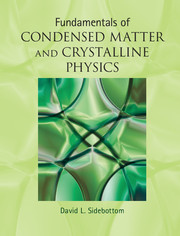 Fundamentals of Condensed Matter and Crystalline Physics
Fundamentals of Condensed Matter and Crystalline Physics from Part III - Dynamics
Published online by Cambridge University Press: 05 August 2012
Introduction
In the last chapter, we investigated the dynamics of liquids whose particles are free to wander about due to the reasonably weak level of inter-particle bonding. In a solid (crystal or glass), bonding between particles is stronger and the translational motion of the particles is arrested. Nevertheless, these “solid” particles continue to move and execute small, localized vibrations about a fixed point in space. In this chapter and the next, we investigate the nature of this vibrational motion and its impact on the thermal properties of a solid. Here we begin by considering a simple model of masses connected by ideal springs to demonstrate how vibrations of individual atoms are, in reality, a consequence of propagating waves traveling through the crystal lattice. In order to connect these waves with the quantum mechanical perspective of each atom behaving as a quantized harmonic oscillator, we find ourselves introducing the concept of a quantum of elastic wave, known as a phonon.
An important outcome of our development of quantized elastic waves is a growing appreciation for a special region of reciprocal space known as the Brillouin zone, which is populated by all the wave vectors, K, corresponding to allowed phonon waves in the crystal. For phonons whose K matches the edge of this zone, significant Bragg scattering results, to produce two equivalent standing wave patterns separated by an energy gap. We will revisit the Brillouin zone often in the chapters to come, and we will begin to appreciate the significance of this boundary for the motion of all waves that attempt to travel within a crystal.
To save this book to your Kindle, first ensure [email protected] is added to your Approved Personal Document E-mail List under your Personal Document Settings on the Manage Your Content and Devices page of your Amazon account. Then enter the ‘name’ part of your Kindle email address below. Find out more about saving to your Kindle.
Note you can select to save to either the @free.kindle.com or @kindle.com variations. ‘@free.kindle.com’ emails are free but can only be saved to your device when it is connected to wi-fi. ‘@kindle.com’ emails can be delivered even when you are not connected to wi-fi, but note that service fees apply.
Find out more about the Kindle Personal Document Service.
To save content items to your account, please confirm that you agree to abide by our usage policies. If this is the first time you use this feature, you will be asked to authorise Cambridge Core to connect with your account. Find out more about saving content to Dropbox.
To save content items to your account, please confirm that you agree to abide by our usage policies. If this is the first time you use this feature, you will be asked to authorise Cambridge Core to connect with your account. Find out more about saving content to Google Drive.